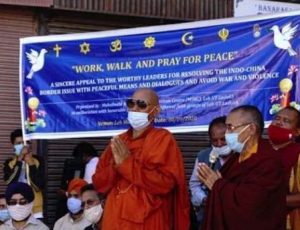Beginner’s Mind is a special project from BDG collecting insightful essays written by US college students who have attended experiential-learning courses related to Buddhism. Some of the authors identify as Buddhists, for others it is their first encounter with the Buddhadharma. All are sharing reflections and impressions on what they’ve learned, how it has impacted their lives, and how they might continue to engage with the teaching.
Dolores Marcial-Modesto wrote this essay for her class Brutal Buddhism at Trinity College in Hartford, Connecticut, where she recently graduated with a BS honors in psychology and a minor in religious studies. Dolores is currently conducting biomedical research in Colorado and hopes to apply for MD-PhD programs in the near future.

Beyond the Stereotype: Challenging the Perception of a Peaceful Religion
The name of the course was already captivating: Brutal Buddhism. What brutality can the word Buddhism carry? Prior to this course, I took a class called Buddhist Thought during my sophomore year in 2021. We learned all that we could about the Buddha’s teachings, and it all related back to compassion, non-attachment, and non-harming. The terms brutality or violence were never mentioned, at least according to my memory. Therefore, I decided to explore how Buddhism interacted with violence during my spring semester of senior year (2023).
The first section of the class was learning about the teachings of the Buddha, which started off smoothly. The material felt familiar, so nothing was alarming at first. I remember the review session for the midterm exam and how we played mini-games such as charades to remember terms. Just imagine hearing the term bhumisparsha mudra and seeing people instantly collapse into the famous hand-touching-earth gesture.
After the midterm was over, we transitioned to the Orientalism framework. It was my first time learning about the imaginary perspectives that the West creates about the Middle East and Asia through stereotypical depictions. (Said 2012, 3:08) Intercultural mimesis (Tweed 2008) and the media (King 1999) have exacerbated these stereotypes, but they also feed us into perceiving Buddhism as only capable of peace and harmony, with no space for violence. Although the class duration was only an hour and 15 minutes, that discussion provided a foundation for the remainder of the course.
The idea of a peaceful religion was shattered when I heard a monk from Myanmar say “. . . we do not accept illegal immigrants,” (Al Jazeera 2019, 14:49) despite uttering words such as “peacemakers” and “accepting” in the same sentence. That statement echoed the xenophobic sentiments prevailing in the United States, and it especially hit home for me as a child of immigrant parents. We learned that Buddhists have been employing the “just war” ideology for years, rationalizing violence and killing under the notion of protecting the Dharma. I began to think about how often we tend to separate Buddhism from other religions because we do not want to believe that they can do harm. While at the same time, Buddhists in Myanmar are taking away the human rights of the Rohingya people. (Al Jazeera 2019, 19:45)
This class made me scrutinize my own viewpoints and evaluate the sources (e.g., media) to which I was exposed. I recalled that during the semester, whenever I mentioned taking a Buddhism class, most people made comments about meditation and tranquility. I then realized that I was constantly living what I was learning.
Despite not being religious myself, I chose to minor in religious studies because I acknowledge the significance of religion in the lives of many people. Brutal Buddhism helped me understand that every religion has the potential to cause harm. However, it is up to the individual to acknowledge this and take action, even if it means standing up against their own religion. It was a privilege to learn about such an intense topic in one semester. Nevertheless, I hope to continue exploring challenging topics that might seem unconventional at first, just like studying Brutal Buddhism.
References
“An Unholy Alliance: Monks and the Military in Myanmar.” Rohingya | Al Jazeera, 18 March 2019. https://www.aljazeera.com/program/featured-documentaries/2019/3/18/an-unholy-alliance-monks-and-the-military-in-myanmar
King, Richard. 1999. “Orientalism and the Discovery of ‘Buddhism.’” In Orientalism and Religion. London: Routledge.
Said, Edward. 2012. “Edward Said on Orientalism.” YouTube. 28 October 2012. https://youtu.be/fVC8EYd_Z_g
Tweed, Thomas A. 2008. “Why Are Buddhists so Nice? Media Representations of Buddhism and Islam in the United States since 1945.” In Material Religion 4 (1): 91–93. https://doi.org/10.2752/175183408×288168
Related features from BDG
A Tree Grows in Hartford
Brutal Buddhism – Looking for Meaning and Connection in a Fragmented World
Embracing the Unknown – A New Perspective on Buddhism











